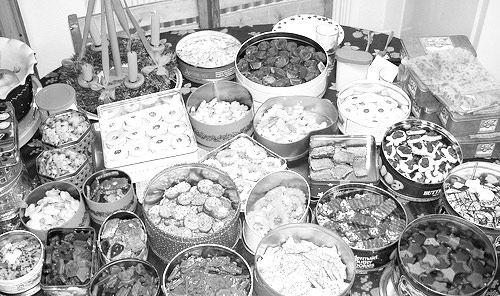Ho-ho-hone healthy holiday habits
 CREDIT: TOOMUCHONHERPLATE.COM
CREDIT: TOOMUCHONHERPLATE.COMThe holiday season brings with it many sweet treats that can sabotage any diet.
With Christmas comes a picturesque turkey dinner often filled with mounds of mashed potatoes, gravy, stuffing and fresh rolls — and don't forget Christmas cookies and Grandma's homemade pumpkin pie. One word comes to mind when thinking of all these delicious foods: carbs. With little time for exercising and more time for Christmas parties and dinners, it can be easy to lose track of our belly size over the break.
Before the festive meals even begin, we are bombarded by advertisements for new speciality holiday drinks such as Tim Hortons' Candy Cane Hot Chocolate or Starbucks' Eggnog Latte. Both sound scrumptious, but according to registered dietician Jennifer Broxterman, drinks can be one of our biggest problems. "I think what sneaks away from people is a lot of the alcohol and beverage calories because they don't register the same way that a solid food calorie does with the brain."
Melissa Vandermeer, instructor in the Food and Nutrition Management program at Fanshawe, said she was surprised to find out how unhealthy one of her favourite holiday beverages is. "I ordered a Caramel Brul�e Latte (from Starbucks), with no whip and skim milk, and the Grande was still over 300 calories. You look at about 500 calories per meal and you just consumed 300 calories just for a beverage." She added that it's important to treat these fancy holiday drinks as a treat and not as a beverage alongside a meal or a snack.
Along with the unhealthy drinks come easily accessible treats and baked goods. Whether it's at home or at the office, Broxterman warned that snacking becomes dangerous at this time of year. "It's the junk and cookies and chocolates that sit around the house after hosting a party or during that week between Christmas and New Year's � Those kinds of things, they're little temptations left around the house, and a bit here or a nibble there or a handful of chocolate isn't registering as how many calories are really adding up." Sticking to the "out of sight, out of mind" policy can really help, she added.
A break from school and work shouldn't mean a break from exercising. Routines often get broken over the holidays, which can mean a decrease in physical activity and missing regular work-outs. This also contributes to weight gain over the Christmas season. "In the winter months, people who tend to rely on outdoor activities aren't getting out as much, so those people already aren't getting as much physical activity," said Vandermeer. "Now with Christmas coming up and everyone being so busy, it becomes even less."
Many Christmas parties have turned into pot-luck dinners or snack fests, making them another prime location to put on the pounds. When it comes to attending parties, Broxterman had three big tips: avoid dips (such as spinach or artichoke dips) that are high in fat and calories; never go to a party hungry; and stick to the "two plate" rule. "If you're at a party that has finger food and you're picking at different items, make a rule for yourself that you're never going to eat straight out of a serving bowl, but instead use the small plates or napkins available. Then tell yourself you can have two fillups of your plate, but you can only stick to what you put on your plate," she suggested.
So you've kept up with your workout regiment, made it through the Christmas parties and temptations at work, but now you have to face a number of family feasts. There are ways to watch your waist while enjoying a big holiday meal. Turkey, thank goodness, is a pretty healthy Christmas meat (minus all of that gravy). White meat without skin is the healthiest choice. Vandermeer's family has opted for healthier options in the past. "With the turkey we started removing the skin because that's where you get the saturated fats from. If you put lots of seasoning and vegetables around the turkey when you're roasting, it gets enough flavour and juice on its own." When choosing vegetables, she suggested steaming them and not adding butter. She also recommended squash as a side because of its natural sugars and sweet taste.
When it comes to physically putting the food on your plate, Broxterman recommended watching your portion sizes. "(On) 'the healthy plate,' 50 per cent of the plate is veggies — it could be salad or cooked green beans; a quarter of the plate would be a starchy food, which includes potatoes, stuffing, bread or rolls; and the remaining quarter would be the turkey or a protein. One way to achieve this is by actually putting the vegetables on your plate first," she suggested.
If you're afraid of eating too much dessert, just remember that it's okay to indulge — just watch your portions. "Anyone who tries to sacrifice too much ends up eating more of it later on anyways," said Vandermeer, "so it's better to take smaller pieces and enjoy and savour what you're eating."













